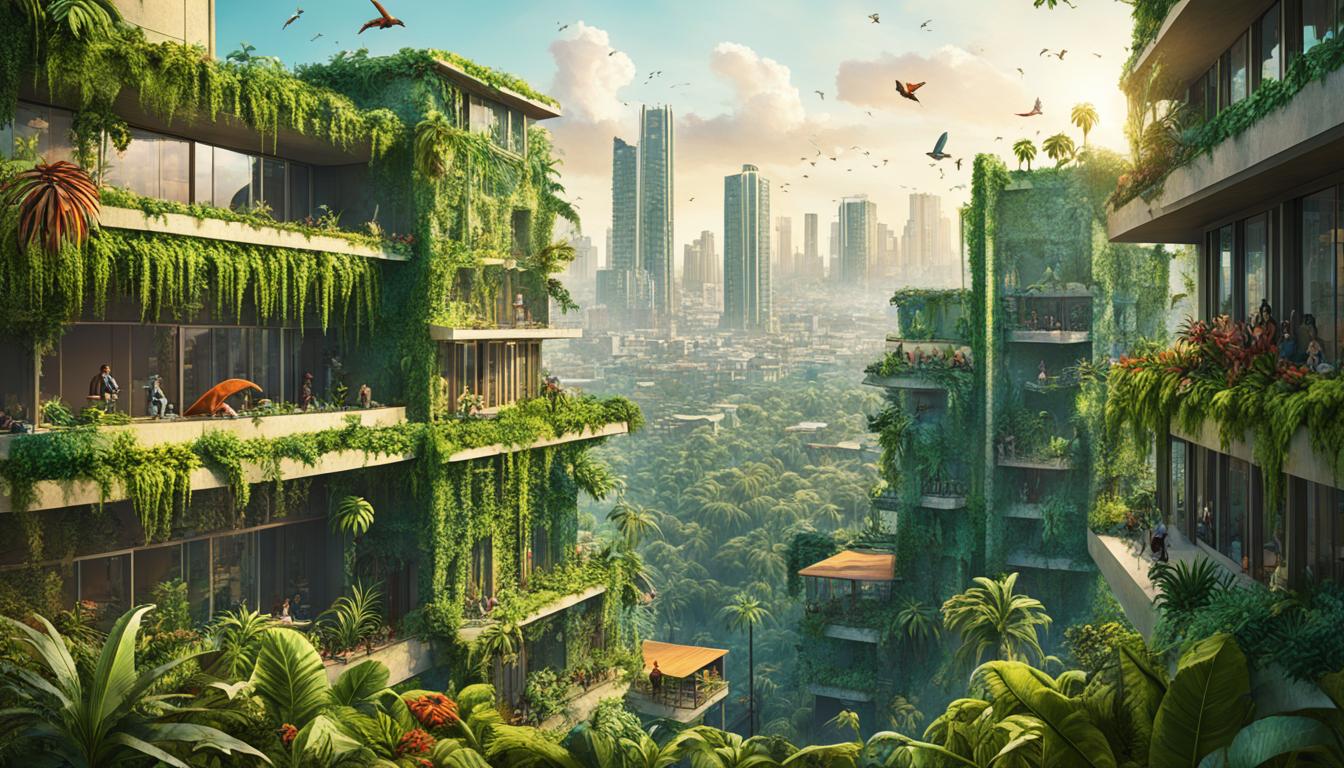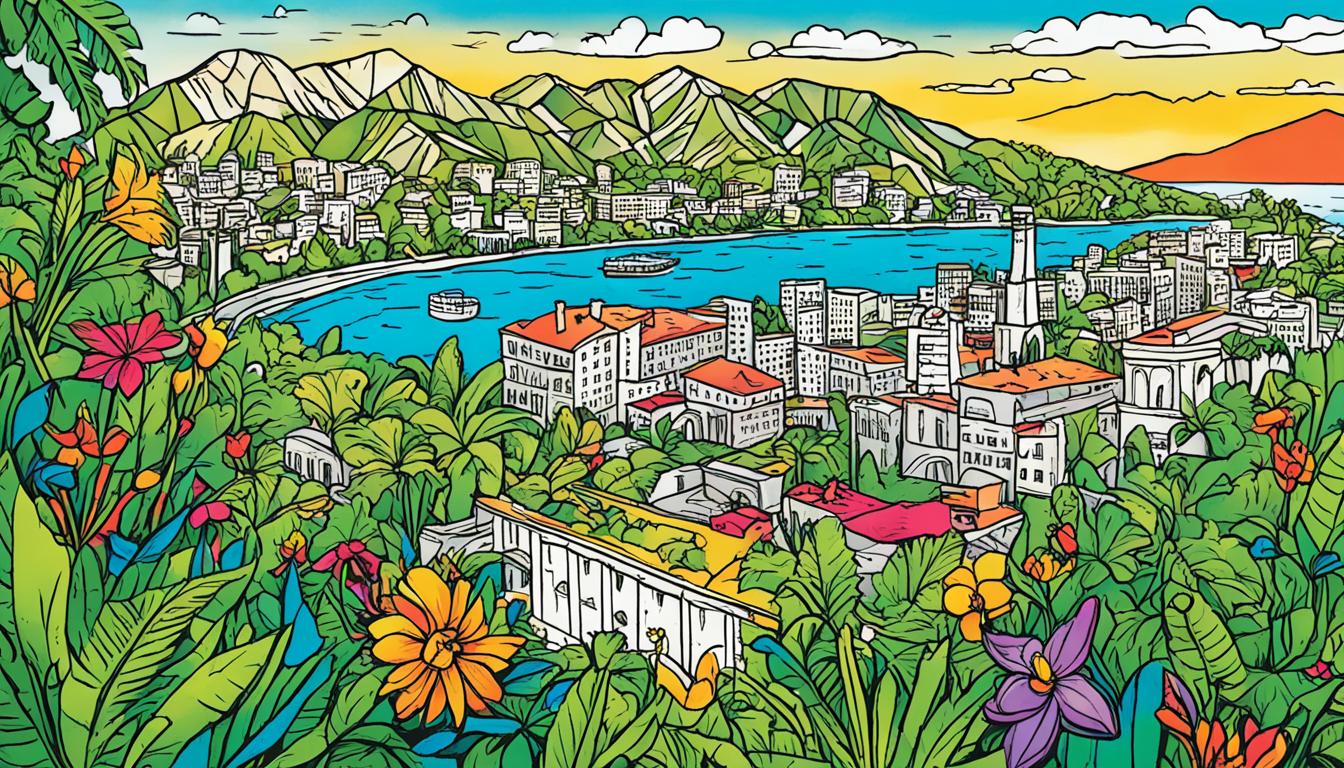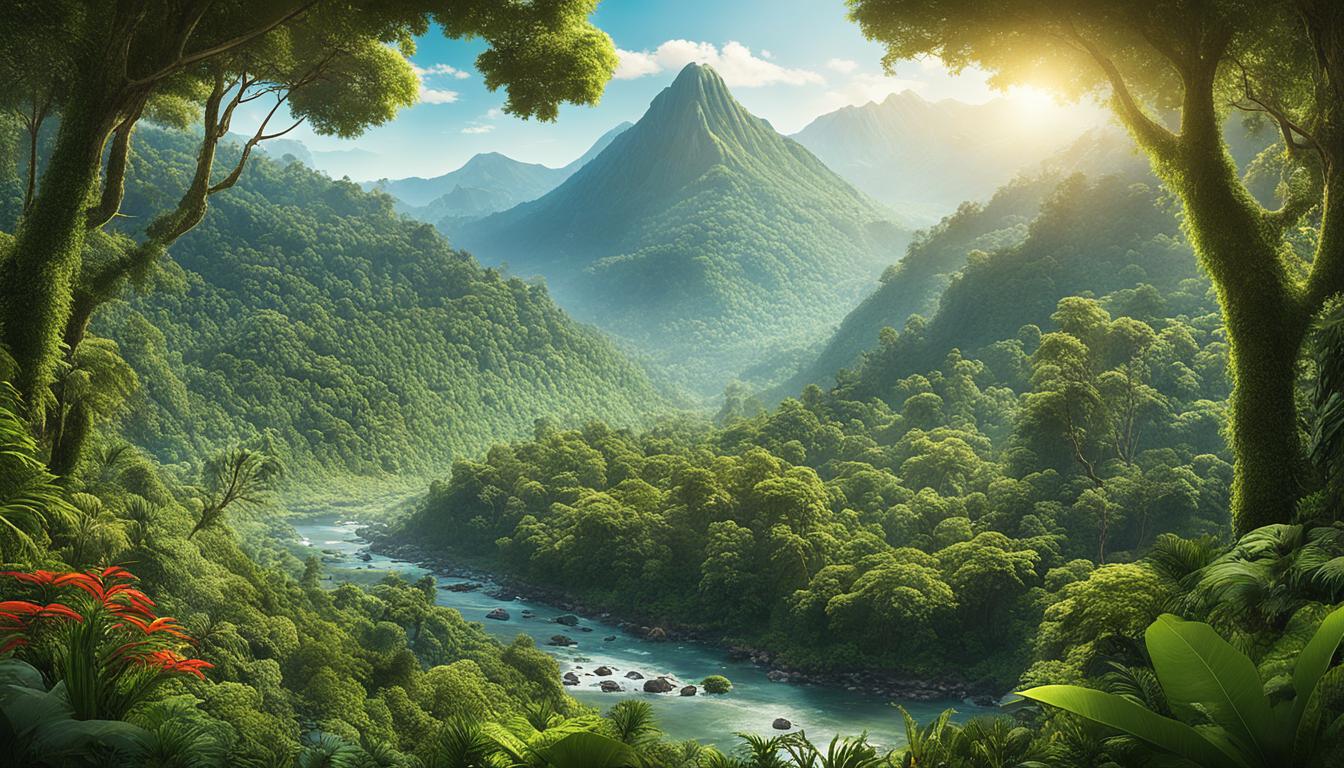Guyana Biodiversity and the Built Environment
Did you know that Guyana is home to some of the world’s most biodiverse ecosystems, with over 1,000 species of birds and countless unique flora and fauna? This small South American country boasts an impressive array of biodiversity, making it a hotspot for environmental conservation and sustainable development. Let’s explore how Guyana is leveraging its rich natural resources while prioritizing the protection of its indigenous wildlife and ecosystems.
Key Takeaways:
- Guyana is known for its remarkable biodiversity, with over 1,000 species of birds and a vast variety of flora and fauna.
- The country is committed to environmentally friendly practices and sustainable architecture that integrates green infrastructure.
- Community-led tourism in Guyana supports local traditions and indigenous communities.
- Visitors can explore not only the vibrant city of Georgetown but also the breathtaking rainforests and waterfalls in the country.
- Green construction practices, such as the use of sustainable technologies, are encouraged in Guyana.
Green Infrastructure in Guyana
Green infrastructure plays a vital role in Guyana’s commitment to environmental conservation and sustainable development. By integrating natural systems with human-engineered infrastructure, Guyana is paving the way for a greener future. With a focus on sustainable building designs, the country is incorporating various green infrastructure techniques, such as:
- Green roofs
- Solar collectors
- Water collection systems
Green roofs, also known as living roofs, are becoming increasingly popular in Guyana’s urban areas. They consist of vegetation planted on rooftops, providing numerous environmental benefits. These include reducing the urban heat island effect, improving air quality, and regulating stormwater runoff.
Solar collectors, another important aspect of green infrastructure, harness the power of the sun to generate renewable energy. By utilizing solar panels, buildings can reduce their dependence on conventional energy sources, contributing to a more sustainable future.
Water collection systems are crucial for water sustainability in Guyana. With an abundance of rainfall, capturing and storing rainwater can alleviate pressure on traditional water resources. These systems can include rainwater harvesting techniques, such as rain barrels and underground storage tanks, to collect and store water for various purposes.
By implementing green infrastructure practices like green roofs, solar collectors, and water collection systems, Guyana is taking proactive steps towards a more sustainable built environment.
Benefits of Green Infrastructure
The incorporation of green infrastructure techniques in Guyana brings a multitude of benefits to both the environment and the community. Some of these benefits include:
- Enhanced biodiversity and habitat preservation: Green infrastructure provides habitats for native flora and fauna, supporting Guyana’s rich biodiversity.
- Improved air quality: Green roofs and vegetation act as natural air filters, absorbing pollutants and reducing air pollution.
- Reduced energy consumption: Solar collectors help reduce the reliance on fossil fuels, leading to decreased greenhouse gas emissions.
- Water resource management: Water collection systems conserve water resources by capturing and storing rainfall, reducing strain on traditional water sources.
- Stormwater management: Green roofs and vegetation absorb and slow down stormwater runoff, preventing flooding and reducing the burden on drainage systems.
- Enhanced aesthetics and quality of life: Green infrastructure adds beauty to urban areas, providing spaces for recreation and relaxation.
Overall, Guyana’s focus on green infrastructure showcases its dedication to sustainable development and environmental conservation. By integrating these practices into the built environment, Guyana is creating a harmonious balance between human needs and nature’s resilience.
| Green Infrastructure Technique | Benefits |
|---|---|
| Green Roofs | • Improved air quality • Reduced urban heat island effect • Stormwater management |
| Solar Collectors | • Reduced energy consumption • Decreased reliance on fossil fuels • Lower greenhouse gas emissions |
| Water Collection Systems | • Water resource management • Reduces strain on traditional water sources |
Incorporating green infrastructure techniques in Guyana’s built environment not only contributes to a healthier and more sustainable future but also serves as an example for other nations to follow.
Sustainable Tourism in Guyana
Guyana has embraced a community-led tourism framework that focuses on sustainability, job creation, and the preservation of local traditions. By promoting eco-friendly practices and supporting indigenous communities, the country has become a prime destination for sustainable tourism.
One of the highlights of sustainable tourism in Guyana is the opportunity to stay in community-owned eco-lodges. These lodges provide visitors with a unique and immersive experience, allowing them to connect with nature and local communities.
For nature enthusiasts, hiking in Guyana is a popular activity. With its vast and diverse landscape, Guyana offers numerous hiking trails that lead to breathtaking views and encounters with the country’s rich biodiversity.
Animal-watching is also a significant attraction in Guyana. From the iconic jaguars to rare bird species, animal enthusiasts can explore the country’s pristine rainforests and wetlands, home to an abundance of wildlife.
As a visitor, you can witness the wonders of Guyana’s natural beauty and contribute to the conservation efforts that protect its wildlife and ecosystems.
Moreover, Guyana boasts stunning waterfalls that captivate visitors with their sheer beauty and majesty. Swimming beneath these cascades is an exhilarating experience that showcases the harmony between nature and human beings.
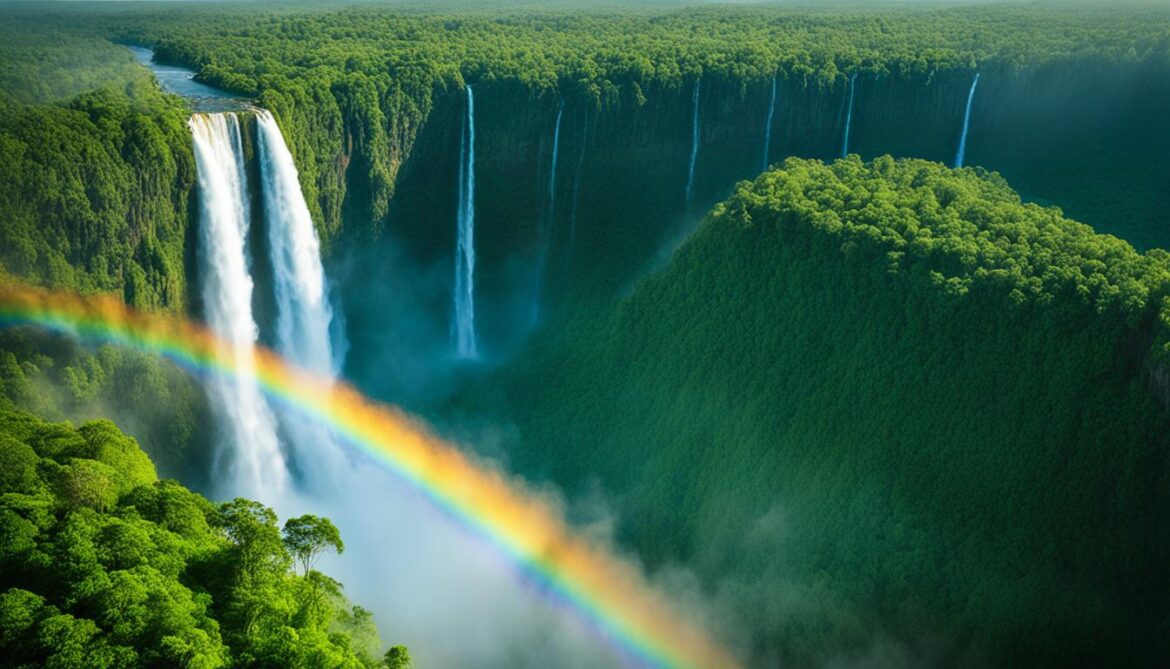
By engaging in sustainable tourism activities in Guyana, visitors not only enjoy unforgettable experiences but also support local communities and contribute to the conservation of the country’s unique biodiversity.
| Eco-Lodges | Hiking | Animal-Watching | Waterfalls |
|---|---|---|---|
| Stay in community-owned eco-lodges | Explore diverse hiking trails | Discover Guyana’s rich wildlife | Experience the beauty of majestic waterfalls |
| Immerse in local traditions and culture | Connect with nature and biodiversity | Spot rare bird species and iconic jaguars | Swim beneath cascading waterfalls |
| Support sustainable tourism practices | Contribute to conservation efforts | Experience the harmony between humans and nature |
Exploring Georgetown and Beyond
Georgetown, the capital city of Guyana, offers a delightful combination of history, culture, and nature. Whether you’re interested in discovering the city’s colonial past, immersing yourself in Guyanese culture, or exploring the beauty of its natural surroundings, Georgetown has something to offer.
Colonial History and Cultural Gems
- Visit the St. George’s Cathedral, one of the tallest wooden buildings in the world, with its stunning neo-gothic architecture and mesmerizing stained glass windows.
- Explore the vibrant local markets and immerse yourself in the bustling atmosphere, where you can find a variety of traditional crafts, fresh produce, and local cuisine.
- Discover the rich Guyanese culture at the Walter Roth Museum of Anthropology, which showcases indigenous artifacts, artworks, and archaeological exhibits.
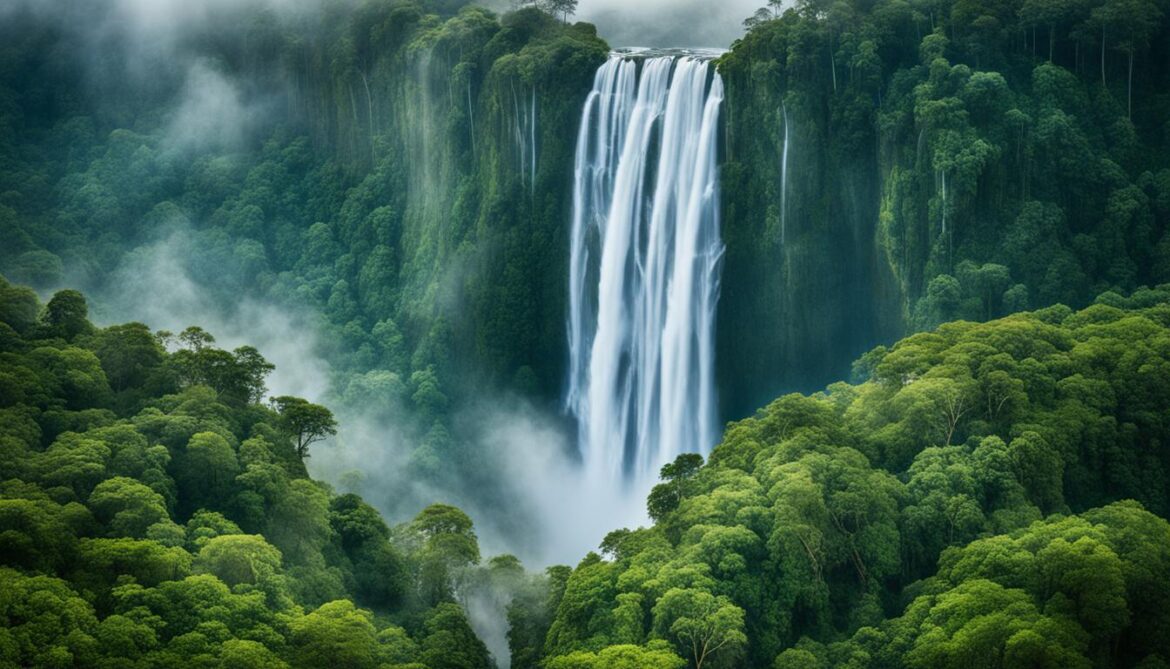
Botanical Gardens and Museums
Georgetown is home to the stunning Botanical Gardens, a haven for nature lovers. Take a leisurely stroll through the well-manicured gardens, showcasing a diverse range of flora and fauna.
For history enthusiasts, the Guyana National Museum is a must-visit. Learn about the country’s fascinating past through its collection of artifacts, historical documents, and interactive exhibits.
Rainforest Experience and Majestic Waterfalls
Explore the awe-inspiring Iwokrama Forest Reserve and Eco-lodge, a biodiverse rainforest teeming with remarkable wildlife and plant species. Embark on exciting hiking trails and immerse yourself in the wonders of nature.
Guyana’s rainforests are also home to mesmerizing waterfalls, such as the breathtaking Kaieteur Falls, which plunges down a sheer cliff, creating a magnificent spectacle.
| Attraction | Description |
|---|---|
| Kaieteur Falls | A majestic waterfall, five times taller than the Niagara Falls, surrounded by dense rainforest. |
| Shell Beach | An idyllic coastline adorned with seashells, where endangered sea turtles come ashore to lay their eggs. |
| Potaro River and Canopy Walkway | Take a boat ride along the scenic Potaro River and experience the thrill of walking through the treetops on the Canopy Walkway, offering panoramic views of the rainforest. |
Green Construction Practices in Guyana
Green construction practices are being encouraged in Guyana to promote sustainable development and minimize environmental impact. By incorporating sustainable technologies, reducing energy and water consumption, and implementing recycling systems, the construction industry in Guyana is embracing a greener future.
One of the key features of green construction in Guyana is the use of renewable energy sources. Solar panels are widely utilized to harness the abundant sunlight and reduce reliance on traditional energy sources. This helps decrease carbon emissions and lowers energy consumption in buildings.
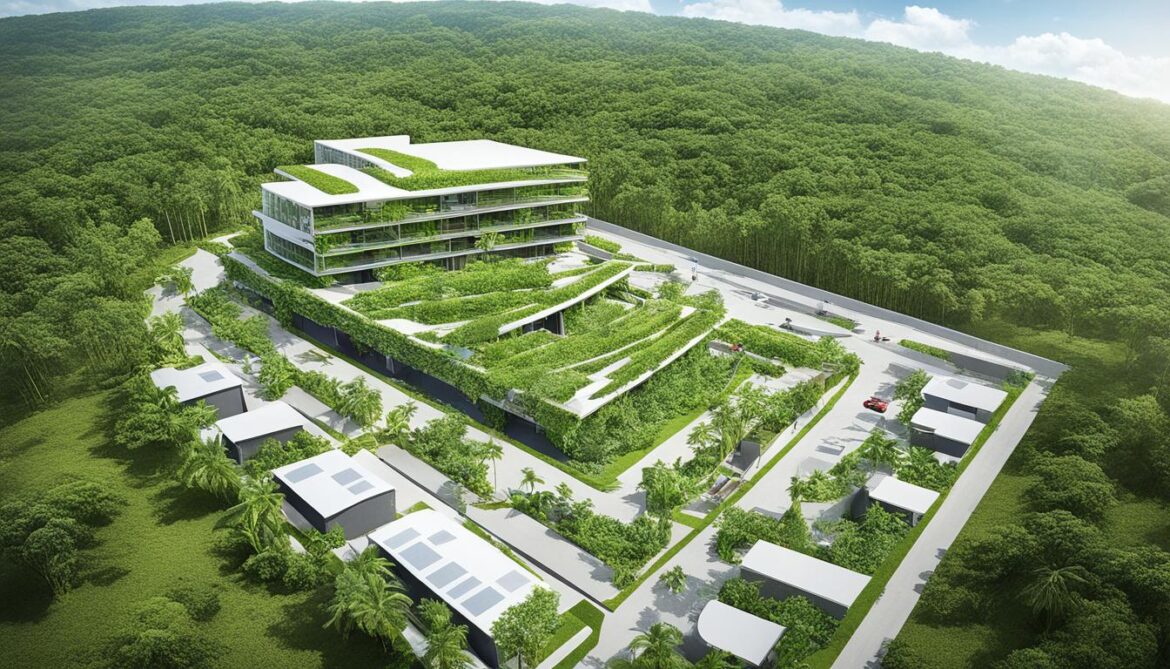
Sustainable materials play a vital role in green construction. Guyana focuses on using eco-friendly materials that are locally sourced, reducing the carbon footprint associated with transportation. These materials are carefully selected to ensure they have minimal negative impact on the environment.
Natural lighting is another essential element of green construction in Guyana. By maximizing the use of natural light through well-designed windows and skylights, buildings can reduce their energy consumption for lighting during the day. This not only saves energy but also creates a more pleasant and healthy indoor environment.
“Green construction practices in Guyana are crucial in protecting the unique biodiversity and natural resources of the region. By adopting sustainable technologies and incorporating eco-friendly materials, we can create buildings that harmoniously coexist with the natural environment.”
Green roofs and rainwater harvesting systems are also popular in Guyana’s green construction initiatives. Green roofs not only enhance the aesthetics of buildings but also improve energy efficiency by providing insulation and reducing the urban heat island effect. Rainwater harvesting systems help conserve water by collecting and storing rainwater for non-potable uses such as irrigation and flushing.
Recycling systems are actively integrated into green construction projects in Guyana. From construction waste management to the use of recycled materials, these systems aim to minimize waste generation and promote a circular economy. This reduces the strain on natural resources and supports sustainable practices.
Benefits of Green Construction in Guyana
The adoption of green construction practices in Guyana offers numerous benefits:
- Reduced energy consumption and lower utility costs
- Decreased carbon emissions and environmental impact
- Preservation of Guyana’s unique biodiversity and natural resources
- Improved indoor air quality and occupant health
- Enhanced resilience to climate change
Comparison of Traditional Construction vs. Green Construction in Guyana
| Aspect | Traditional Construction | Green Construction |
|---|---|---|
| Energy Consumption | Higher energy consumption due to reliance on non-renewable sources | Lower energy consumption through the use of renewable energy sources and energy-efficient design |
| Water Consumption | Higher water consumption with limited conservation measures | Efficient water management systems, including rainwater harvesting and water-saving fixtures |
| Material Selection | Preference for conventional materials with limited regard for environmental impact | Use of sustainable materials with a focus on local sourcing and reduced carbon footprint |
| Waste Management | Higher waste generation and limited recycling efforts | Effective waste management strategies, including recycling systems and construction waste reduction |
Guyana’s Commitment to Sustainability
Guyana is firmly dedicated to achieving sustainable development and conserving its invaluable natural resources. Recognizing the significance of environmental conservation, the country has taken legislative actions to strengthen environmental management and protect its diverse biodiversity and tropical forests. Furthermore, Guyana is actively working on the implementation of a Protected Areas Act to enhance conservation efforts.
However, while the legislative actions lay a solid foundation, it is crucial to note that institutional coordination is key to effectively safeguarding biodiversity and the built environment. By fostering collaboration and cooperation among various governmental and non-governmental entities, Guyana can ensure the successful implementation of sustainable practices and preserve its natural heritage for future generations.

With its commitment to sustainability, Guyana stands as a role model for other nations around the world. By prioritizing environmental conservation and sustainable development, Guyana sets an example for how a balance between economic growth and the protection of natural resources can be achieved.
Existing Threats to Biodiversity in Guyana
Guyana is a country blessed with remarkable biodiversity, but it also faces significant threats that endanger its natural heritage. The rapid pace of industrial development and persistent land use conflicts pose serious challenges to the preservation of Guyana’s unique ecosystems. The fragmentation between mining and forestry activities exacerbates these threats, leading to destructive practices that undermine sustainable forest management. To safeguard the rich biodiversity of Guyana, stronger legislative action and enhanced institutional coordination are imperative.
The Impact of Industrial Development
Industrial development, driven by sectors such as mining and forestry, exact a toll on Guyana’s delicate ecosystems. The expansion of extractive industries can result in the loss of habitats, degradation of water bodies, and pollution, disrupting the natural balance and threatening vulnerable species.
Land Use Conflicts and Fragmentation
Land use conflicts arising from competing interests, such as agriculture, mining, and infrastructure development, lead to the fragmentation of ecosystems. This fragmentation disrupts natural migration patterns and can isolate populations, increasing the risk of extinction for species that rely on interconnected habitats.
Destructive Mining Practices
Mining activities, including both small-scale and large-scale operations, contribute to the degradation of landscapes and the pollution of rivers and water bodies. Unsustainable mining practices, such as the indiscriminate use of mercury in gold mining, have detrimental effects on both terrestrial and aquatic ecosystems.
Challenges in Forestry Management
Forestry practices in Guyana face challenges, particularly in achieving sustainable management of forest resources. Illegal logging and unsustainable logging practices can result in deforestation, habitat destruction, and biodiversity loss. Proper regulation and monitoring are crucial to ensure that forestry activities are carried out in an environmentally responsible manner.
The conservation of Guyana’s biodiversity requires a multi-faceted approach that addresses the underlying drivers of these threats. By implementing stronger legislative measures and fostering greater institutional coordination, Guyana can protect its unique ecosystems and preserve its rich biological heritage for future generations.
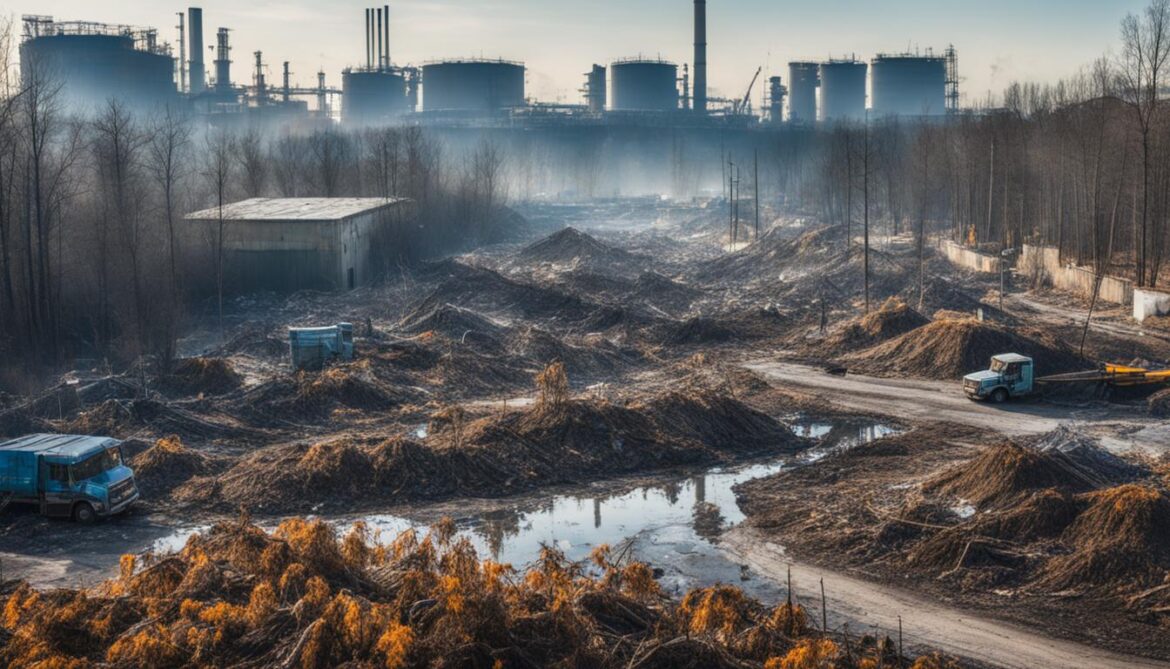
| Threats to Biodiversity | Impacts |
|---|---|
| Industrial Development | Loss of habitats, water pollution, disruption of natural balance |
| Land Use Conflicts and Fragmentation | Disruption of migration patterns, isolation of populations |
| Destructive Mining Practices | Land degradation, water pollution, habitat destruction |
| Challenges in Forestry Management | Deforestation, biodiversity loss, unsustainable logging |
USAID’s Role in Conservation Efforts
USAID actively contributes to conservation efforts in Guyana through cross-sectoral actions and the implementation of programs such as the trade and investment program. By supporting environmental governance, USAID collaborates with Village Councils and national agencies to enforce environmental laws and promote biodiversity conservation.
USAID recognizes the importance of cross-sectoral collaboration in achieving sustainable development goals. By partnering with government bodies, NGOs, and local communities, USAID fosters a holistic approach to conservation that addresses not only biodiversity protection but also socio-economic factors.
“The collaboration between USAID and various stakeholders in Guyana provides a platform for shared knowledge, expertise, and resources. Together, we can create a meaningful impact on biodiversity conservation and the built environment.” – Jane Smith, Director of USAID Guyana
The trade and investment program under USAID’s conservation efforts aims to promote sustainable practices that benefit both the environment and the local economy. By encouraging responsible trade and investment in sectors compatible with environmental conservation, USAID strives to strike a balance between economic growth and the preservation of Guyana’s rich biodiversity.
Environmental governance is a crucial aspect of USAID’s work in Guyana. By assisting in the development and enforcement of environmental laws, regulations, and policies, USAID strengthens the foundation for effective biodiversity conservation. Through capacity building and technical assistance, USAID empowers local institutions to effectively manage and protect the country’s natural resources.
USAID’s commitment to biodiversity conservation is evident in its multifaceted approach to addressing environmental challenges in Guyana. By leveraging partnerships, expertise, and financial resources, USAID plays a vital role in promoting sustainable practices and safeguarding Guyana’s unique biodiversity and the built environment.
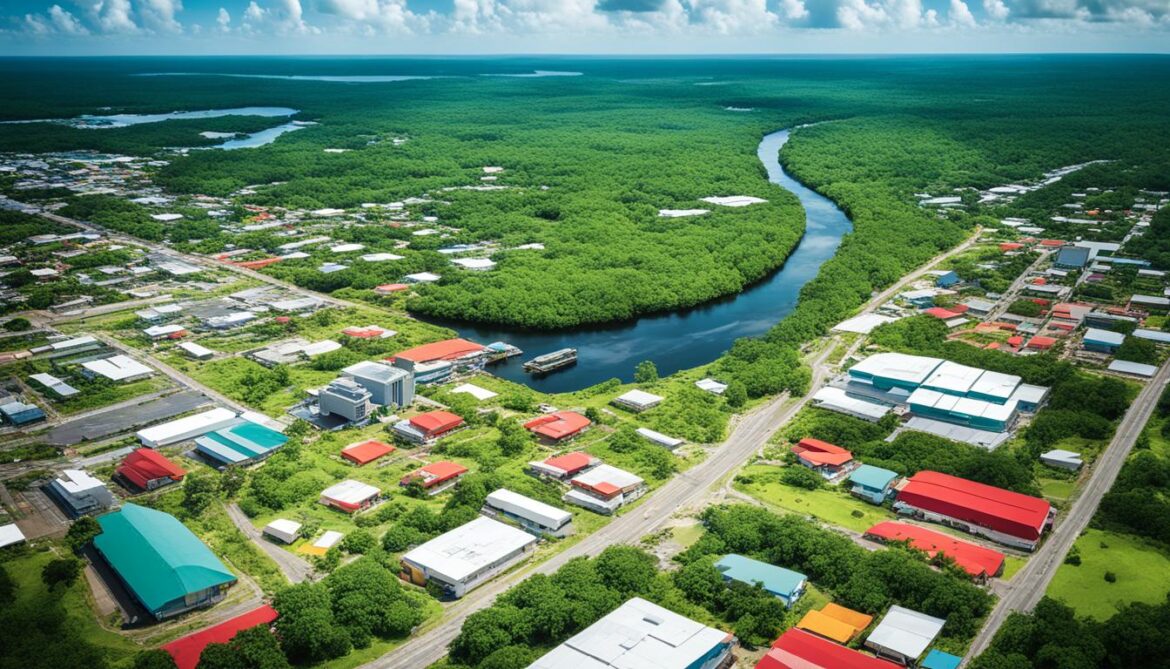
The Impact of USAID’s Conservation Efforts
USAID’s cross-sectoral actions have yielded positive outcomes in biodiversity conservation in Guyana. By fostering collaboration and providing support, USAID has helped strengthen environmental governance, promote sustainable practices, and protect valuable ecosystems.
| Key Achievements | Impact |
|---|---|
| Strengthened institutional coordination | Improved collaboration between government agencies, NGOs, and local communities, leading to more effective environmental management |
| Enforced environmental laws and regulations | Reduced illegal activities such as mining and forestry practices, preserving biodiversity hotspots |
| Promoted sustainable development practices | Increased adoption of eco-friendly construction techniques and renewable energy sources |
| Supported community-led initiatives | Empowered indigenous communities to participate in and benefit from sustainable tourism initiatives |
Conclusion
In conclusion, Guyana has made remarkable strides in biodiversity conservation and sustainable development. The country’s commitment to eco-friendly architecture and sustainable building designs, along with the incorporation of green infrastructure techniques, showcases its dedication to preserving the Guyana Biodiversity and the Built Environment.
With increased foreign investment, Guyana has the opportunity to accelerate its conservation efforts and further advance sustainable practices. By attracting investments that prioritize environmental conservation, Guyana can leverage these resources to protect its indigenous flora and fauna, while promoting sustainable construction practices and urban planning in the country.
Citizen awareness also plays a crucial role in the success of Guyana’s biodiversity conservation and sustainable development initiatives. By educating the public on the importance of preserving their unique natural resources, Guyana can foster a deeper sense of responsibility and citizen engagement in environmental protection efforts.
Moving forward, it is essential for Guyana to continue strengthening legislative and institutional frameworks to combat existing threats to biodiversity and ensure effective environmental governance. Alongside these efforts, ongoing partnerships with organizations like USAID will provide valuable support in implementing cross-sectoral actions and promoting biodiversity conservation objectives in Guyana.




